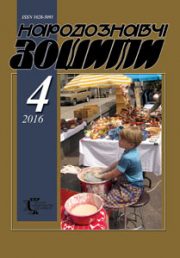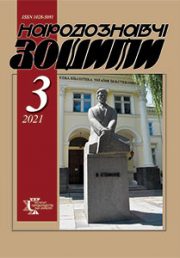The Ethnology Notebooks. 2019, № 6 (150), 1536—1541
UDK7.042+7.048
DOI https://doi.org/10.15407/nz2019.06.1536
ANIMAL’S DECORATIVE PATTERNIN THE SUBSTANTIVE WORLD OF THE CRIMEAN TATARS
FRANZHULO Valeriia
ORCID ID: https://orcid.org/0000-0003-0468-8634
Graduate student of Lviv
National Academy of Arts,
Founder and leader
Design studio «Frandgulo»
38, Kubiiovycha Street, 79011, Lviv, Ukraine
Contacts: e-mail: frandgulo@mail.ru
Abstract. The urgency of accessing the language of the ornament is undoubted, it is a basic element in the system of transfer of cultural heritage between numerous generations of people of different historical eras. Moreover, the picture of the world created by the language of the ornament reflects a system of value orientations of a certain period in the development of culture.
Problem Statement. The artistic ornament is involved in the architectural construction as an element of composition and a means of artistic expression. The ornament was used as signs to help determine a person’s social and social position. He was given values associated with different images and phenomena of nature.
Purpose. The central object of this study is the world of ornamental art, created and broadcast using a specific language of symbols, in particular, the so-called «zoomorphic symbolism» in the subject world of the Crimean Tatars.
Methods. One of the difficult problems in the study of ornament is the difficulty in deciphering and dating the original origin, as well as belonging to a particular ethnic group. Over the years of the existence of decorative art, various types of patterns have emerged: geometric, floral, complex, etc. Early forms of ornament — geometric.Over time the abstract geometric pattern was combined with conditionally-realistic floral and animal’s decorative pattern.
Results. Stylistics, shaping, ornamentation indicate the openness of the Crimean Tatar art of various influences. The main cultural landmark was the Ottoman Empire, which defines the nature of artistic culture, life style, architectural traditions. The cultural traditions of the neighboring ethnic groups contributed to the enrichment of the Crimean Tatar art, and it also had an impact on their art.
Conclusion. The decorative and applied art of the Crimean Tatars retained its identity, built on the style and canons of Islamic art and its own ethnic tradition, which allows to speak about the historical significance and independence of this phenomenon in the culture of Crimea.
Keywords: the decoratively-applied art, Crimea, animal’s decorative pattern, Crimean Tatars, subject world.
Received 30.11.2019
REFERENCES
Kunafina, D.R., Donguzova, E.I., & Donguzov, K.A. (2016). Ornament in the architecture of Ufa. Modern technologies and techniques in architectural and art education (Collection of materials of the International Scientificand Methodical Conference). Rostov-on-Don [in Russian].
Yamilov, R.R. (2009). Semantics zoomorphic images on the tissues and attributes of the costume of the Golden Hordeera. Golden Horde Heritage (Materials of the International Scientific Conference «Politicaland Socio-Economic History of the Golden Horde (ХШ—XV centuries)»). Kazan [in Russian].
Asanova, A.E. (2011). People’s ornamentas a source of ethnogenesis. World of science, culture, education, 4 (29), 325—329 [in Russian].
Besentnov, N.P. (2010). Artistic language of ornament. Moscow: Vlados [in Russian].
Kadyrov, A.J. (2016). Modern Crimean Tatar painting. Tavric scientific observer, 12—2 (17), 117—120 [in Russian].
Fabre, A. (1859). The honourable antiquities of Crimea and their associated memories. Odessa [in Russian].
Skrzhinsky, E.H. (1971). Barbaro and Contarini about Russia: To the history of Italian-Russian ties in XV century. Leningrad: Science [in Russian].
Kuftin, B.A. (1924). On the Material Culture of Tatars: South Coast: Field Notebook. Moscow: IAE Archive [in Russian].
Bernstam, A.N. (1931). Housing of the Crimean foothills. Moscow: Ogiz [in Russian].
Chapurina, P.J. (1938). Ornamental sewing of Crimea. Moscow: KOIZ [in Russian].
Alekseyev, S. (1954). Architectural ornament. Moscow: State publishing house of literature on construction and architecture [in Russian].
Ambroz, L.K. (1966). On the symbolism of Russian peasant embroidery of archaic type. Soviet archaeology, 1, 61—76 [in Russian].





